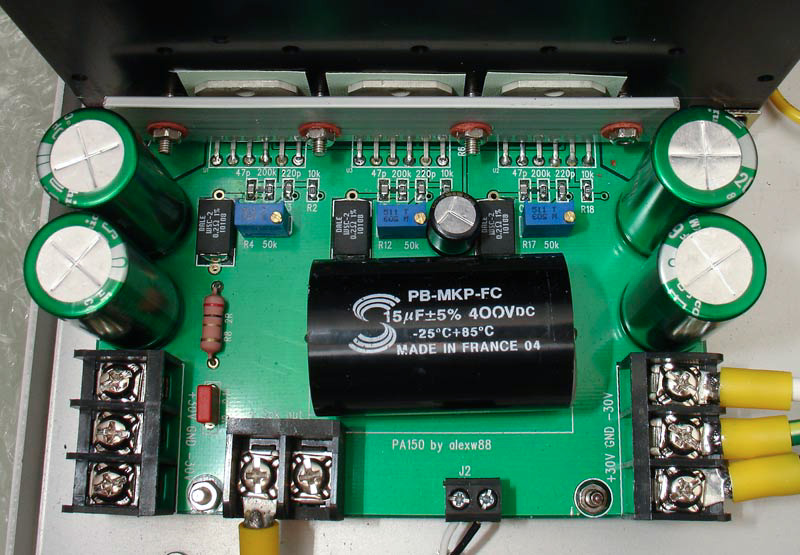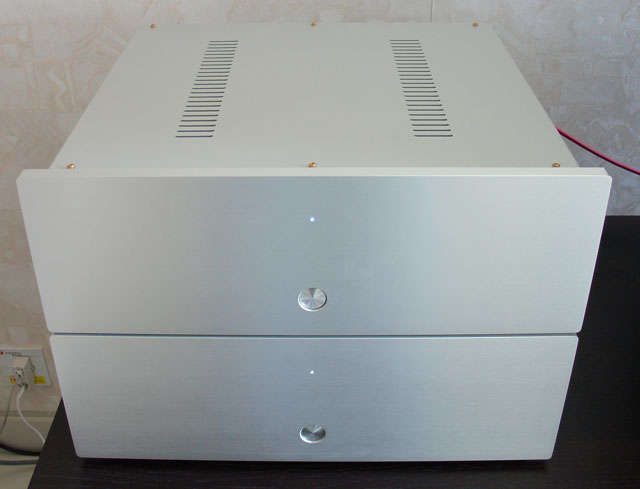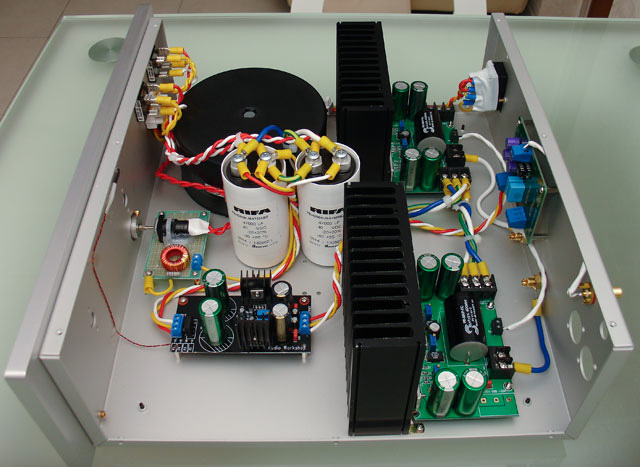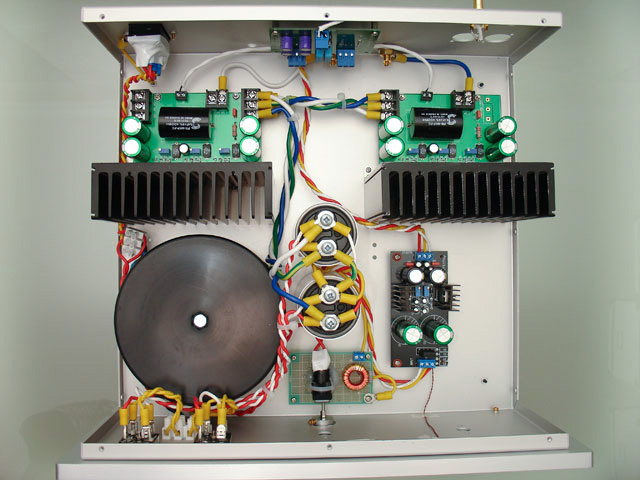| |
After I built several LM3875 and LM3886 gainclone amplifiers, I was totally impressed by their audiophile sound quality. My design goal is to create a audio power amplifier that can deliver 300W into my 4-ohm DIY speaker with low distortion. I want it to produce deep, tight and punchy bass while keeping the excellent mids and highs from my other gainclones. My design uses a PCB to hold 3 paralleled 3886s (i.e. PA150), and then I use the DRV134 to bridge 2 of the PA150 PCB boards. The function of DRV134 is to convert the un-balanced input signal to a balanced signal, so that the non-inverted signal is fed to one PA150, and the inverted signal is fed the another PA150. One of the PA150 is connected to the speaker's positive input, and the other PA150 is connected to the speaker's negative input. Because of this push-pull configuration, the total gain of the amplifier is doubled. Each PA150 has a gain of 20, so the gain of the BPA300 is 40.

I used the LM3886 in the inverted configuration, the reason is that I can use a trim pot to adjust the DC offset of each 3886. National's application note AN1192 suggested to use servo to set the DC offset to zero, but I prefer this simpler solution. After some adjustment, I can get the DC offset of each 3886 to about 9mV, because this is a push pull configuration, the DC offset at speaker terminal would be very close to 0mV.
The PCB is designed in a way that the center area is filled with ground. Which the +30V supply line is at the outer area of the back of the PCB. The -30V supply line is at the outer area of the front of the PCB.
The PA150 PCB - The resistors R2 and R3 are 0.1% parts, you could also buy 1% parts and hand match them to 0.1% accuracy. For the R7 0.2ohm 2W resistor, the PCB is designed to accept either SMD or thru hole component.
The unbalanced input signal is converted to balanced signal using the DRV134. The DRV134 board circuit is very simple, similar to the reference circuit in the Burr Brown DRV134 data sheet.
I choose to use SMD components because I think it is easier for board layout, and can have a shorter signal path. Using surface mount components allows me to create a smaller board. The trimmer is to adjust the DC offset of each 3886 so that the DC is at about the same level.
The 3886s are mounted to the heat sink using a aluminum bar. This mounting method can apply a more even pressure on the 3886s, and thus better heat transfer to the heat sink. I used the LM3886T, the non-isolated version for better heat dissipation. I used Solen 15uF as the DC blocking capacitor, because it not expensive and performance is quite good.
All the power input, signal input and speaker output uses screw type connector for easy assembly and testing.
I have WIMA 0.1uF bypass capacitors soldered at the 3886's supply pin directly, on the back side of the PCB. These capacitors are used to filter out the high frequency noise of the power supply. 4 Nichicon MUSE 2200uF capacitors are used in each board for supply filtering.
Power supply is a 2x25V 500VA encapsulated transformer for each channel. After rectification and at low load, the voltage is at about 34.5V. At full load, the voltage dropped to about 31V. This transformer is very quiet and vibration free. Basically I cannot hear any noise from it. These RIFA big can capacitors can deliver huge current, which is required to produce a deep and punchy bass. This is the voltage regulator board for the DRV134, I used LT317 and LT337 voltage regulator chip.
The PCB ground is connected to the chassis / AC ground via a choke and a 10ohm resistor connected in series. The choke is to block the HF noise, and the 10ohm resistor is to reduce the ground current which would cause some 50Hz hum.
I am building this as a mono-block for better heat dissipation. During testing at 300W this amplifier can become very hot. At normal music listening volume the heatsink is generally warm. Notice all the power and signal wires are twisted to minimize noise.
I used RMAA to do some basic testing.
Testing setup : PC sound card -> Amp line in -> Amp speaker out -> 4 ohm load -> Passive Preamp -> mixer preamp -> PC sound card in.
Passive preamp is to lower to amp's output voltage to line level, mixer preamp is to convert the balanced signal to non-balanced for sound card input. RMAA test result for 1W, 10W, 100W, and 294W at 4ohm load. My sound card's loop back THD is about 0.0017%, so the BPA300 THD result here may be limited by the sound card.
Listening impression: the sound characteristic of this BPA300 is similar to my other LM3886 and LM3875 gainclone. These mono blocks has deeper sound stage, better stereo imaging, much tighter and better controlled bass. Overall I can say this truly is a high end audio equipment.




|
|
|
| |
Accurate LC Meter
Build your own Accurate LC Meter (Capacitance Inductance Meter) and start making your own coils and inductors. This LC Meter allows to measure incredibly small inductances making it perfect tool for making all types of RF coils and inductors. LC Meter can measure inductances starting from 10nH - 1000nH, 1uH - 1000uH, 1mH - 100mH and capacitances from 0.1pF up to 900nF. The circuit includes an auto ranging as well as reset switch and produces very accurate and stable readings. |
|
PIC Volt Ampere Meter
Volt Ampere Meter measures voltage of 0-70V or 0-500V with 100mV resolution and current consumption 0-10A or more with 10mA resolution. The meter is a perfect addition to any power supply, battery chargers and other electronic projects where voltage and current must be monitored. The meter uses PIC16F876A microcontroller with 16x2 backlighted LCD. |
|
|
|
60MHz Frequency Meter / Counter
Frequency Meter / Counter measures frequency from 10Hz to 60MHz with 10Hz resolution. It is a very useful bench test equipment for testing and finding out the frequency of various devices with unknown frequency such as oscillators, radio receivers, transmitters, function generators, crystals, etc. |
|
1Hz - 2MHz XR2206 Function Generator
1Hz - 2MHz XR2206 Function Generator produces high quality sine, square and triangle waveforms of high-stability and accuracy. The output waveforms can be both amplitude and frequency modulated. Output of 1Hz - 2MHz XR2206 Function Generator can be connected directly to 60MHz Counter for setting precise frequency output. |
|
|
|
BA1404 HI-FI Stereo FM Transmitter
Be "On Air" with your own radio station! BA1404 HI-FI Stereo FM Transmitter broadcasts high quality stereo signal in 88MHz - 108MHz FM band. It can be connected to any type of stereo audio source such as iPod, Computer, Laptop, CD Player, Walkman, Television, Satellite Receiver, Tape Deck or other stereo system to transmit stereo sound with excellent clarity throughout your home, office, yard or camp ground. |
|
USB IO Board
USB IO Board is a tiny spectacular little development board / parallel port replacement featuring PIC18F2455/PIC18F2550 microcontroller. USB IO Board is compatible with Windows / Mac OSX / Linux computers. When attached to Windows IO board will show up as RS232 COM port. You can control 16 individual microcontroller I/O pins by sending simple serial commands. USB IO Board is self-powered by USB port and can provide up to 500mA for electronic projects. USB IO Board is breadboard compatible. |
|
|
|
|
ESR Meter / Capacitance / Inductance / Transistor Tester Kit
ESR Meter kit is an amazing multimeter that measures ESR values, capacitance (100pF - 20,000uF), inductance, resistance (0.1 Ohm - 20 MOhm), tests many different types of transistors such as NPN, PNP, FETs, MOSFETs, Thyristors, SCRs, Triacs and many types of diodes. It also analyzes transistor's characteristics such as voltage and gain. It is an irreplaceable tool for troubleshooting and repairing electronic equipment by determining performance and health of electrolytic capacitors. Unlike other ESR Meters that only measure ESR value this one measures capacitor's ESR value as well as its capacitance all at the same time. |
|
Audiophile Headphone Amplifier Kit
Audiophile headphone amplifier kit includes high quality audio grade components such as Burr Brown OPA2134 opamp, ALPS volume control potentiometer, Ti TLE2426 rail splitter, Ultra-Low ESR 220uF/25V Panasonic FM filtering capacitors, High quality WIMA input and decoupling capacitors and Vishay Dale resistors. 8-DIP machined IC socket allows to swap OPA2134 with many other dual opamp chips such as OPA2132, OPA2227, OPA2228, dual OPA132, OPA627, etc. Headphone amplifier is small enough to fit in Altoids tin box, and thanks to low power consumption may be supplied from a single 9V battery. |
|
|
|
|
|
Arduino Prototype Kit
Arduino Prototype is a spectacular development board fully compatible with Arduino Pro. It's breadboard compatible so it can be plugged into a breadboard for quick prototyping, and it has VCC & GND power pins available on both sides of PCB. It's small, power efficient, yet customizable through onboard 2 x 7 perfboard that can be used for connecting various sensors and connectors. Arduino Prototype uses all standard through-hole components for easy construction, two of which are hidden underneath IC socket. Board features 28-PIN DIP IC socket, user replaceable ATmega328 microcontroller flashed with Arduino bootloader, 16MHz crystal resonator and a reset switch. It has 14 digital input/output pins (0-13) of which 6 can be used as PWM outputs and 6 analog inputs (A0-A5). Arduino sketches are uploaded through any USB-Serial adapter connected to 6-PIN ICSP female header. Board is supplied by 2-5V voltage and may be powered by a battery such as Lithium Ion cell, two AA cells, external power supply or USB power adapter. |
|
200m 4-Channel 433MHz Wireless RF Remote Control
Having the ability to control various appliances inside or outside of your house wirelessly is a huge convenience, and can make your life much easier and fun. RF remote control provides long range of up to 200m / 650ft and can find many uses for controlling different devices, and it works even through the walls. You can control lights, fans, AC system, computer, printer, amplifier, robots, garage door, security systems, motor-driven curtains, motorized window blinds, door locks, sprinklers, motorized projection screens and anything else you can think of. |
|
|
|